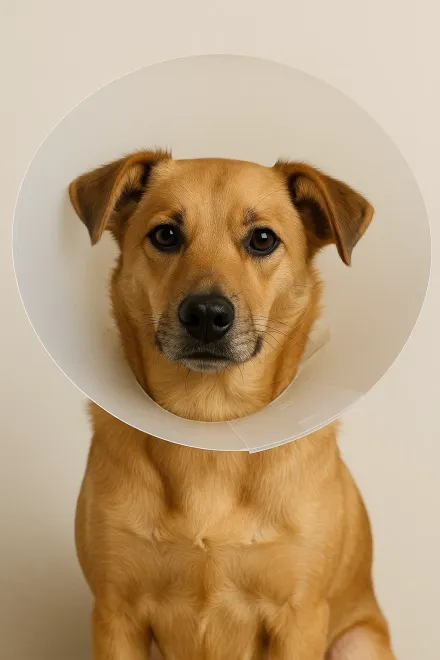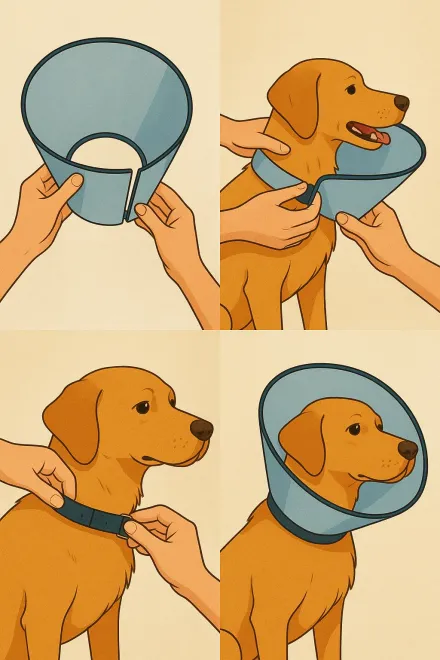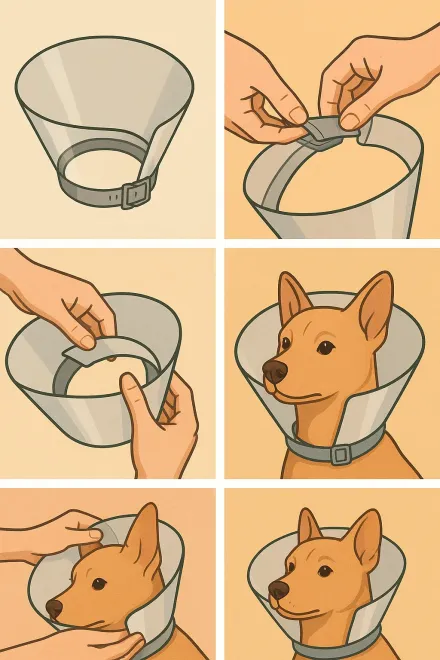How to put an Elizabethan collar correctly
The Elizabethan collar, also known as a cone or recovery collar for dogs and cats, is an essential accessory when our pet has undergone surgery or has a wound they must not lick or scratch. Although its placement may seem simple, many owners feel insecure when using it for the first time. Knowing how to put on an Elizabethan collar properly not only ensures that it fulfills its protective function, but also prevents unnecessary discomfort for the animal.
In this detailed guide you will learn step by step how to put the Elizabethan collar on your dog or cat, what precautions to take, the most common mistakes, and some practical tips to help your pet tolerate it better. In addition, we will review alternatives and expert recommendations to make the process easier both for you and your furry companion.
See recommended Elizabethan collars on Amazon
What is an Elizabethan collar and what is it for?
The Elizabethan collar is a cone-shaped device, usually made of plastic or soft materials, that is placed around a pet's neck. Its purpose is to prevent the dog or cat from licking, biting, or scratching areas of their body that need protection, whether after surgery, in cases of open wounds, or to avoid skin infections.
Its name comes from the large stiff collars worn in the era of Elizabeth I of England, hence the term "Elizabethan". Although today there are more modern and ergonomic models, they all serve the same essential function: protecting the animal's recovery.
The main uses include:
- Preventing a dog from removing stitches after surgery.
- Stopping them from licking wounds or areas with dermatitis.
- Reducing scratching of ears affected by otitis or infections.
- Helping wounds heal without the need for additional bandages.
In short, it is a temporary but crucial accessory in many stages of our pets' lives. Putting it on properly is key to ensuring it serves its purpose.
How to put on an Elizabethan collar step by step
Learning how to put on an Elizabethan collar correctly is essential for your pet to feel as comfortable as possible and not manage to remove it easily. Here is a simple procedure:
- Choose the right size: the collar should extend beyond your pet's snout, but not be excessively large. Ideally, it should stick out 3 to 5 cm.
- Prepare the collar: if detachable, assemble the parts before approaching your pet to reduce handling time.
- Put the collar on gently: slide the dog's or cat's head through the central hole carefully, making sure it doesn’t catch on the ears.
- Adjust the closure: some models fasten with Velcro, straps, or directly onto the pet's regular collar. It should be secure but not tight around the neck.
- Check comfort: your pet should be able to breathe, eat, and drink without difficulty, although movement will feel clumsier at first.
It is normal for your pet to try to remove the collar or seem uncomfortable at the beginning. With patience and some tricks, such as offering treats or distracting with play, they will adapt faster.


Common mistakes when putting on an Elizabethan collar
Many owners make mistakes when putting on an Elizabethan collar, reducing its effectiveness or causing unnecessary discomfort to the animal. Here are some of the most common:
- Choosing the wrong size: if too small, the pet will reach the wound; if too large, it will hinder walking.
- Not securing it properly: a loose collar may come off easily. It must be fastened securely, though not too tightly.
- Putting it on without supervision: during the first hours it is recommended to observe the pet to ensure they adapt.
- Not giving time to adjust: some dogs and cats become very stressed if not allowed progressive adaptation.
- Ignoring extreme discomfort: if the pet cannot eat or drink, the collar should be adjusted or replaced with an alternative model.
Avoiding these mistakes will make the experience much easier and ensure the collar fulfills its main function: protecting your pet during recovery.
Frequently asked questions about how to put on an Elizabethan collar
How do I know if the Elizabethan collar is properly fitted?
The Elizabethan collar should be snug enough not to slip off, but not so tight that it presses on the neck. A good rule is being able to slide two fingers between the collar and your pet's neck. Also, make sure they can breathe, drink, and eat without major difficulty. If you notice excessive panting, coughing, or skin marks, it means it is too tight.
How long should my pet wear the Elizabethan collar?
The length of time depends on the reason for use. Normally, it is worn between 7 and 14 days after surgery, until stitches are removed or the wound heals. It is important to follow your vet's recommendations and not remove it too early, since even a few minutes without it can be enough for the pet to lick or bite the healing area.
Can I take the Elizabethan collar off while my dog eats?
It is not recommended to remove it, as your dog may use that moment to lick the wound. If eating is difficult, try raising the bowl or using a narrower and deeper one. Only in extreme cases, and under direct supervision, should you remove it for a few minutes, but always put it back on immediately after.
Are there more comfortable alternatives to the plastic Elizabethan collar?
Yes, there are options such as inflatable collars, soft fabric cones, or even post-surgery bodysuits. These may be more comfortable for some pets, although they do not always offer the same effectiveness as the classic collar. The choice depends on the type of wound and the pet's behavior, so consulting your vet before switching models is always recommended.
What should I do if my pet does not adapt to the Elizabethan collar?
Most pets need an adaptation period of several hours or even days. During this time it is normal for them to walk awkwardly, bump into objects, or try to take it off. You can help by offering rewards, distractions, and adapting the environment. If after some time they still show extreme anxiety, consult your vet to consider a more comfortable alternative model.
How can I help my cat tolerate the Elizabethan collar?
Cats are usually more sensitive to this type of accessory, and it is common for them to freeze or walk backwards. The best approach is to accompany them, encourage them with play, and make sure they have easy access to food, water, and the litter box. In some cases, soft collars or post-surgery shirts are a better accepted option for cats.
What size Elizabethan collar should I choose?
The collar should extend at least 3 to 5 cm beyond your pet's snout. This way, they will not reach the wound with their tongue or paws. It is also important that the central hole is not too wide, as it could slip off. Most manufacturers provide sizing guides based on the pet's weight and breed.
